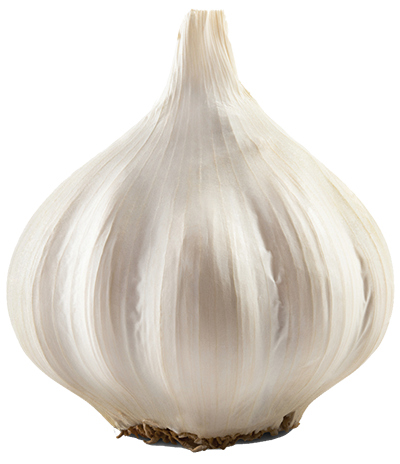 Garlic: An easy-to-grow and tasty protector
Garlic: An easy-to-grow and tasty protector
It has been used for some 7,000 years to fuel the building of pyramids and the athleticism of early Olympians, ward off vampires and other pests (including some humans), treat all manner of illnesses and add exceptional flavor to food.
“It” is garlic, a relative of onions, shallots, leeks and chives (all members of the Allium genus) that originated in Asia but became naturalized across the globe as humankind embraced it for its culinary, medicinal and mystical qualities.
In early human times, garlic was used in many religious rituals and was eaten to increase strength and enhance physical performance. It was also thought to be effective against any number of ailments, a fact born out today — scientists have found that eating garlic can help protect us from cancer, hypertension and other illnesses and provides antioxidant and antimicrobial benefits. Though there’s no scientific proof that garlic fends off garden pests and vampires, it does appear to repel mosquitoes and fleas (though it should be used judiciously with pets).
Most of us, however, just love garlic for its taste, and these days we have hundreds of garlic varieties to choose from, each with its own nuanced flavor. Garlic is also quite easy to grow in Alabama, though knowing a little about the types of garlic and their growing requirements helps ensure the best success. So here’s a little garlic primer.
True garlics are divided into two categories – hardneck and softneck. Like their names, hardneck garlics have stiff stems that are typically removed at harvest while softneck garlics have soft stems that can be braided into garlands for curing, storing and displaying. Elephant garlic, which is quite popular for its giant bulbs, is actually a type of leek rather than a true garlic and produces milder-tasting cloves.
Because all these plants originated in colder climates, the greatest challenge for Alabama growers is providing just the right amount of cold to help them develop big, plump bulbs. And because softneck garlics typically require the fewest chilling hours, they are a great choice for growing in Alabama; however, there’s nothing wrong with trying them all in your garden.
Regardless of the type you choose, garlics should be planted in the fall (October and November for north and central Alabama and on through January in south Alabama). Refrigerating the bulbs for 6 to 8 weeks prior to planting can also give them an extra boost, though chilling requirements vary depending on the variety, so check their planting guides to figure out how long they need to be kept in the fridge.
Prepare your garlic bed now
Garlics prefer loose, well-drained soils with lots of organic matter and they don’t compete well with weeds. While we can’t plant them right now, we can use this spring and summer to prepare a garlic bed for fall planting. (They can be a bit invasive, so giving them a bed to themselves is a good idea.)
Choose a spot with partial sun, but shady enough so the soil stays cool as the bulbs mature. If the soil gets too warm too fast it can slow down the bulbs’ development. You can also lay a wooden board, sheet of shade cloth or a loose, deep layer of mulch on top of the soil near the base of the plants in early spring to keep the soil cooler.
Garlic is typically ready to harvest in Alabama during May and June after the plants’ leaves begin to brown and die away. Carefully dig up the bulbs, shake off any excess dirt (do not wash them, though) and hang or lay them out to cure in a cool, shaded and well-ventilated spot for about a month. This curing process helps eliminate that green garlic flavor and enriches their flavors.
Cured garlic keeps for 9 months or longer without refrigeration, so you’ll have some at hand all year to use in your own dishes (or try some of the garlic recipes in this month’s Alabama Living food section on page 46) and of course to keep those pesky ailments, bugs and vampires away. Oh, and hang on to some of the biggest, nicest bulbs to replant the following fall.
To learn more about growing garlic in Alabama, check out the Alabama Cooperative Extension publication Add Garlic to Your Garden (ANR-1093), which can be found at www.aces.edu/pubs/docs/A/ANR-1093/ANR-1093.pdf) or the Southern Garden Growers Guide at http://greyduckgarlic.com/Southern_Garlic_Grower_Guide.html.
March Tips
[list]
- If you haven’t already done so, get a soil test!
- Amend your garden soil with compost, manure, peat moss and any fertilizer recommended from your soil test.
- Plant cool season peas, asparagus, horseradish and artichokes.
- Plant eggplant, Brussels sprouts, cauliflower, celery, leeks, onions, early potatoes and radish seeds.
- Plant strawberries, blueberries, grapes and fruit trees.
- Sow seeds for tomatoes, lettuce, carrots and other spring vegetables.
- Transplant shrubs and trees.
- As new spring growth appears, remove winter mulches from garden beds and transplant summer-blooming perennials.
- Get lawn mowers and other garden equipment to ready them for the coming season.
- Prune or pinch back house plants that are getting leggy and begin fertilizing them with a diluted solution of plant food.
- Begin weeding garden or flowerbeds as soon as weeds emerge.
- Clean out birdhouses and feeders.
[/list]
 Katie Jackson is a freelance writer and editor based in Opelika, Alabama. Contact her at [email protected].
Katie Jackson is a freelance writer and editor based in Opelika, Alabama. Contact her at [email protected].




